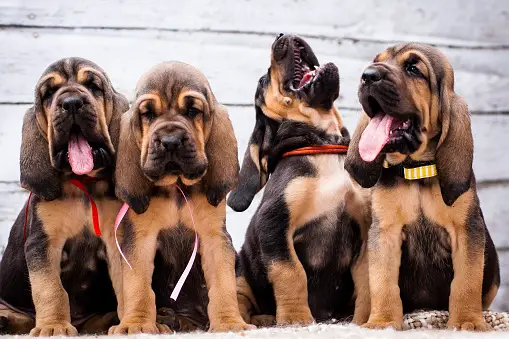Introduction to Mini Bloodhounds

Welcome to the fascinating world of Mini Bloodhounds! These pint-sized versions of the classic Bloodhound breed are known for their keen sense of smell, friendly demeanor, and adorable appearance. If you’re a dog lover, you’ll find Mini Bloodhounds to be a delightful addition to your family.
-
- Overview of the Mini Bloodhound breed
The Mini Bloodhound, also known as the Teacup Bloodhound, is a smaller version of the traditional Bloodhound breed. Despite their smaller size, they still possess the same characteristics that make Bloodhounds so beloved. They are known for their exceptional tracking abilities, thanks to their powerful sense of smell. Mini Bloodhounds are also known for their friendly and loyal nature, making them excellent companions. They have a distinctive droopy face, long ears, and a muscular body. Their coat is short and dense, and it comes in a variety of colors including black and tan, liver and tan, and red.
-
- Mini Bloodhound vs Bloodhound: Key Differences
While Mini Bloodhounds share many traits with their larger counterparts, there are a few key differences. The most obvious difference is their size. Mini Bloodhounds typically weigh between 25-35 pounds and stand about 10-12 inches tall, while traditional Bloodhounds can weigh up to 110 pounds and stand up to 27 inches tall. Despite their smaller stature, Mini Bloodhounds still require plenty of exercise and mental stimulation due to their active nature.
Another difference lies in their lifespan. Mini Bloodhounds tend to live longer than their larger counterparts, with an average lifespan of 12-15 years compared to 10-12 years for a typical Bloodhound. However, like all breeds, individual health and lifestyle factors can greatly influence a dog’s lifespan.
Lastly, while both breeds are known for their tracking abilities, Mini Bloodhounds may not have the same level of endurance as a full-sized Bloodhound. This doesn’t mean they can’t be great trackers, but they may require more breaks and shorter tracking sessions.
Mini Bloodhound Characteristics
Understanding the characteristics of the Mini Bloodhound is essential for any potential owner. These dogs are a smaller version of the traditional Bloodhound breed, but they still carry many of the same traits. Let’s dive into the physical and personality traits of these adorable dogs.
-
Physical Traits
Mini Bloodhounds are a compact version of the standard Bloodhound. They typically stand between 15 to 18 inches tall at the shoulder and weigh between 40 to 60 pounds. They have a short, dense coat that comes in a variety of colors, including black and tan, liver and tan, and red. Their most distinctive features are their long, droopy ears and wrinkled skin, which give them a unique and endearing appearance.
Despite their smaller size, Mini Bloodhounds are strong and sturdy dogs. They have a muscular build, a deep chest, and a long tail. Their eyes are usually a deep brown color and have a kind and gentle expression. Their nose is black and very sensitive, making them excellent scent trackers.
-
Personality Traits
Mini Bloodhounds are known for their friendly and affectionate nature. They are incredibly loyal to their families and get along well with children and other pets. They are also known for their intelligence and keen sense of smell, which makes them excellent at tracking scents.
Despite their hunting instincts, Mini Bloodhounds are generally calm and relaxed at home. They are not overly active dogs, but they do enjoy regular walks and playtime. They can be a bit stubborn at times, but with consistent training, they can be very obedient. They are also known to be quite vocal, often expressing themselves through howls and barks.
In conclusion, Mini Bloodhounds are a smaller, but equally charming version of the standard Bloodhound. Their physical and personality traits make them a wonderful addition to any family. However, like any breed, they require proper care and training to ensure they grow up to be happy and healthy dogs.
Mini Bloodhound Care Guide
Grooming
Proper grooming is essential for maintaining your Mini Bloodhound’s health and happiness. This includes regular coat care, nail trimming, and ear cleaning. Let’s delve into each of these areas:
- Coat CareMini Bloodhounds have short, dense coats that require minimal grooming. However, they are known to shed, so regular brushing can help control this. Use a medium-bristle brush or a hound glove once a week to keep their coat clean and shiny. Bathing should be done only when necessary, as over-bathing can strip the coat of its natural oils, leading to dry and itchy skin. Always use a dog-specific shampoo to maintain the pH balance of their skin.
- Nail TrimmingRegular nail trimming is essential for Mini Bloodhounds. Long nails can cause discomfort and lead to problems with walking. Ideally, nails should be trimmed every 3-4 weeks. If you hear their nails clicking on the floor, it’s a sign they’re too long. Be careful not to cut into the quick, the sensitive part of the nail that contains blood vessels. If you’re unsure about doing this yourself, a professional groomer or vet can help.
- Ear CleaningDue to their long, droopy ears, Mini Bloodhounds are prone to ear infections. Check their ears weekly for any signs of redness, bad odor, or excessive wax build-up. Clean them using a vet-approved ear cleaner. Never insert anything into the ear canal; instead, clean only the outer part. If you notice any signs of infection, consult your vet immediately.
Remember, grooming is not just about maintaining your Mini Bloodhound’s appearance, but also about ensuring their overall health. Regular grooming sessions also provide an excellent opportunity to check for any signs of skin problems, parasites, or abnormalities.
Exercise
Exercise is a crucial part of a Mini Bloodhound’s life. It helps them stay healthy, happy, and well-behaved. Let’s explore the recommended daily exercise for these dogs and some fun activities you can enjoy with your Mini Bloodhound.
-
Recommended Daily Exercise
Mini Bloodhounds are energetic and require regular exercise to maintain their health. Experts recommend at least one hour of exercise per day. This can be broken down into two or three shorter walks, along with playtime. Remember, a tired Mini Bloodhound is a good Mini Bloodhound. Regular exercise can help prevent behavioral problems like excessive barking or chewing.
It’s important to note that puppies and older dogs may not be able to handle this amount of exercise. Always pay attention to your dog’s signals and adjust the exercise routine as needed.
-
Fun Activities for Mini Bloodhounds
Mini Bloodhounds are not just great companions, they are also fun-loving creatures. Here are some fun activities you can do with your Mini Bloodhound:
- Fetch: A classic game of fetch can be a great way to get your Mini Bloodhound moving. Use a soft, easy-to-catch toy to ensure your dog’s safety.
- Hide and Seek: Mini Bloodhounds have an excellent sense of smell. You can play a game of hide and seek with treats or toys, and let your dog use their nose to find them.
- Agility Training: Set up a mini agility course in your backyard. This can include jumps, tunnels, and weave poles. This is not only a great exercise but also a fun way to train your Mini Bloodhound.
Remember, the goal of these activities is not just to tire out your dog, but also to provide mental stimulation and strengthen your bond with them.
Mini Bloodhound Breed Information
Mini Bloodhounds are a smaller version of the well-known Bloodhound breed. They are known for their keen sense of smell and tracking abilities. Let’s delve into the history of this breed and understand the standards that define it.
-
- History of the Breed
The Mini Bloodhound, also known as the Basset Hound, has a rich history that dates back to the 7th century in France. They were bred by monks for hunting purposes, utilizing their exceptional sense of smell. The breed was later brought to England in the 11th century and was highly favored by the royalty. The Mini Bloodhound we know today was developed in the 19th century by selectively breeding smaller Bloodhounds. Despite their size, they retained the excellent tracking abilities of their larger counterparts. For more detailed information, visit the Wikipedia page.
-
- Breed Standards
The Mini Bloodhound is a short-legged breed, typically weighing between 40-60 pounds. They have a distinctive droopy appearance, with long ears and loose skin. Their coat is short and dense, providing protection in all weather conditions. The breed comes in a variety of colors, including black, tan, and white. They are known for their gentle and friendly demeanor, making them excellent family pets. Their keen sense of smell makes them excellent trackers, a trait that is often utilized in search and rescue operations.
Understanding the history and breed standards of the Mini Bloodhound can help potential owners determine if this breed is the right fit for their family. Despite their small size, these dogs are full of personality and have a lot to offer.
Mini Bloodhound Training Tips
Training your Mini Bloodhound can be a rewarding experience for both you and your furry friend. These dogs are intelligent and eager to please, which makes them highly trainable. Here are some key tips to help you in your training journey.
-
- Start Training Early
Like all dogs, Mini Bloodhounds are most receptive to training when they’re young. Start training your Mini Bloodhound as soon as you bring them home. This is the time when they are most eager to learn and their brains are rapidly developing. Early training helps to establish good habits and prevents the development of bad ones. It’s easier to teach a puppy than to correct the behavior of an adult dog.
-
- Use Positive Reinforcement
Positive reinforcement is a proven method for training dogs. This involves rewarding your Mini Bloodhound for good behavior, rather than punishing them for bad behavior. Rewards can be in the form of treats, praise, or playtime. This method not only makes training more enjoyable for your dog, but it also strengthens the bond between you and your pet. According to a study, dogs trained with positive reinforcement are more obedient and exhibit fewer behavioral problems.
-
- Consistency is Key
Consistency is crucial when training your Mini Bloodhound. This means using the same commands and rewards each time. If you’re inconsistent, your dog will become confused and may not respond to your commands. Make sure everyone in your household is on the same page with the training methods and commands. Consistency also applies to your training schedule. Try to set aside a specific time each day for training. This will help your dog understand what is expected of them and when.
In conclusion, training your Mini Bloodhound can be a fun and rewarding experience. By starting early, using positive reinforcement, and being consistent, you can help your dog become a well-behaved and happy member of your family.
Mini Bloodhound Health Issues
Just like any other breed, Mini Bloodhounds can also face certain health problems. It’s important for any dog owner to be aware of these issues and know how to prevent them. Let’s delve into the common health problems and preventive measures for Mini Bloodhounds.
- Common Health ProblemsMini Bloodhounds, due to their genetic makeup, are prone to certain health issues. Here are some of the most common ones:
- Ear Infections: Due to their long, droopy ears, Mini Bloodhounds are more susceptible to ear infections. Regular cleaning can help prevent this issue.
- Hip Dysplasia: This is a common problem in many dog breeds, including Mini Bloodhounds. It’s a condition where the hip joint doesn’t fit together perfectly, leading to pain and mobility issues. Regular vet check-ups can help detect this problem early.
- Eye Conditions: Mini Bloodhounds can also suffer from various eye conditions, such as entropion, where the eyelid rolls inward. This can cause discomfort and, in severe cases, can affect their vision.
- Preventive MeasuresWhile you can’t prevent all health issues, there are steps you can take to help your Mini Bloodhound live a healthier life:
- Regular Vet Check-ups: Regular vet visits can help catch any potential health issues early. Your vet can provide advice on diet, exercise, and overall care to keep your Mini Bloodhound healthy.
- Proper Diet: A balanced diet is crucial for your dog’s health. Make sure your Mini Bloodhound is getting the right nutrients to support their growth and health.
- Regular Exercise: Regular physical activity can help prevent obesity, which can lead to other health problems. Make sure your Mini Bloodhound gets plenty of exercise to keep them fit and healthy.
- Regular Grooming: Regular grooming, including ear cleaning and eye checks, can help prevent infections and other health issues.
Remember, the best way to ensure your Mini Bloodhound’s health is through preventive care. Regular vet visits, a balanced diet, and proper grooming can go a long way in keeping your furry friend healthy and happy.
Mini Bloodhound Diet
As a Mini Bloodhound owner, it’s essential to understand the dietary needs of your furry friend. A balanced diet is crucial for their overall health and well-being. Here, we will discuss the recommended foods for Mini Bloodhounds and the foods you should avoid.
-
- Recommended Foods
Mini Bloodhounds require a diet rich in protein to support their active lifestyle. Foods like chicken, beef, and fish are excellent sources of protein. They also need a good amount of carbohydrates for energy. Brown rice and sweet potatoes are great choices. Additionally, fruits and vegetables like apples, carrots, and peas provide necessary vitamins and minerals. Always ensure that the food is served in appropriate portions to maintain a healthy weight.
-
- Foods to Avoid
While Mini Bloodhounds are not particularly picky eaters, there are certain foods that can be harmful to them. Avoid giving them chocolate, onions, grapes, and raisins as these can be toxic. Also, avoid foods high in salt and sugar. Excessive amounts of dairy products can cause digestive issues. Always be cautious about the treats you give your Mini Bloodhound, ensuring they are healthy and safe.
Remember, every dog is unique and may have specific dietary needs. Always consult with your vet before making significant changes to your Mini Bloodhound’s diet. A healthy diet leads to a happy and active Mini Bloodhound.
For more information about Mini Bloodhounds, you can visit Wikipedia.
Mini Bloodhound Lifespan
Understanding the lifespan of a Mini Bloodhound is crucial for any potential owner. This section will delve into the average lifespan of these adorable dogs and the factors that can influence it.
-
- Average Lifespan
The average lifespan of a Mini Bloodhound is between 10 to 12 years. This is relatively long compared to other dog breeds, making them a great companion for many years. However, it’s important to note that this is just an average. Some Mini Bloodhounds may live longer with proper care and a healthy lifestyle, while others may have a shorter lifespan due to health issues.
-
- Factors Affecting Lifespan
Several factors can affect the lifespan of a Mini Bloodhound. These include:
-
- Genetics: Just like humans, dogs are also affected by their genetic makeup. Some dogs may be predisposed to certain health conditions that can affect their lifespan.
- Diet: A balanced diet is crucial for a dog’s overall health and longevity. Feeding your Mini Bloodhound with high-quality dog food can help them live a longer and healthier life.
- Exercise: Regular exercise can help maintain a healthy weight and keep your dog’s heart healthy, contributing to a longer lifespan.
- Regular Vet Check-ups: Regular vet check-ups can help detect any potential health issues early, allowing for timely treatment and potentially extending your dog’s life.
In conclusion, while the average lifespan of a Mini Bloodhound is 10 to 12 years, many factors can affect this. By providing proper care and a healthy lifestyle, you can help your Mini Bloodhound live a long and happy life.
Mini Bloodhound Puppies
Mini Bloodhound puppies are a bundle of joy and energy. They require special care and training to grow into well-behaved and healthy adult dogs. Here, we will discuss the key aspects of caring for and training these adorable puppies.
-
- Caring for Puppies
Mini Bloodhound puppies, like all puppies, need a lot of care and attention. They should be fed a balanced diet that is specially formulated for puppies. This will ensure they get all the nutrients they need for healthy growth. Regular vet check-ups are also important to monitor their health and to get them vaccinated on time. Mini Bloodhound puppies have a lot of energy, so they need plenty of playtime and exercise. However, be careful not to over-exercise them as their bones are still growing. Lastly, make sure they have a comfortable and safe space to rest and sleep.
-
- Training Puppies
Training a Mini Bloodhound puppy requires patience and consistency. Start with basic commands like ‘sit’, ‘stay’, and ‘come’. Use positive reinforcement techniques such as treats and praises to reward them for good behavior. Socialization is also a crucial part of their training. Expose them to different people, environments, and other animals to help them become well-rounded dogs. Remember, training should be fun for both you and your puppy. If you’re having trouble, don’t hesitate to seek help from a professional dog trainer.
With proper care and training, your Mini Bloodhound puppy will grow into a loyal and loving companion. Remember, every puppy is unique and may require different care and training methods. Always be patient and understanding with your puppy.
Adopting a Mini Bloodhound
Adopting a Mini Bloodhound is a significant decision that requires careful consideration and planning. This section will guide you through the process and provide you with the necessary information to make an informed decision.
-
- Where to Adopt
There are many places where you can adopt a Mini Bloodhound. These include animal shelters, rescue groups, and reputable breeders. It’s essential to research and choose a reputable source to ensure the health and well-being of your potential pet.
Animal shelters and rescue groups often have a wide variety of dogs, including Mini Bloodhounds, looking for a forever home. These organizations usually provide medical care and behavioral assessments before adoption. You can find local shelters and rescue groups through online directories or community resources.
Reputable breeders are another excellent source for Mini Bloodhounds. A good breeder will provide you with information about the puppy’s parents, health screenings, and any potential genetic issues. Always ensure that the breeder is registered and follows ethical breeding practices. You can find reputable breeders through the American Kennel Club or other recognized breed organizations.
-
- What to Consider Before Adopting
Before adopting a Mini Bloodhound, there are several factors you should consider. These include your lifestyle, living situation, and the time and resources you can dedicate to a new pet.
Mini Bloodhounds are active and require regular exercise to stay healthy and happy. They also need mental stimulation, which can be provided through training and interactive toys. If you lead a sedentary lifestyle or are away from home for long periods, a Mini Bloodhound may not be the best fit for you.
Your living situation is also an important consideration. Mini Bloodhounds are adaptable and can live in various environments, but they need enough space to move around comfortably. They also have a strong sense of smell and can be prone to chasing scents, so a secure yard or regular leash walks are essential.
Lastly, consider the financial aspect of owning a pet. Dogs require regular veterinary care, quality food, and other supplies that can add up over time. Make sure you are prepared for the responsibility and cost of pet ownership before adopting a Mini Bloodhound.
Conclusion
-
- Summary of Key Points
Mini Bloodhounds, though smaller in size, carry the same charm and distinctive characteristics as their larger counterparts. They are known for their keen sense of smell, friendly nature, and loyalty. These dogs require a balanced diet, regular exercise, and consistent training to maintain their health and behavior. Potential health issues include hip dysplasia and ear infections, which can be mitigated with regular vet check-ups. Mini Bloodhounds have a lifespan of 10-12 years, making them a long-term commitment for any dog lover.
-
- Final Thoughts on Mini Bloodhounds
Adopting a Mini Bloodhound can be a rewarding experience, offering companionship and unconditional love. These dogs are well-suited for families and individuals who can provide them with the care and attention they need. Despite their potential health issues, their affectionate nature and unique characteristics make them a beloved breed. In conclusion, Mini Bloodhounds are not just pets, but they become a part of your family, bringing joy and happiness with their presence.








